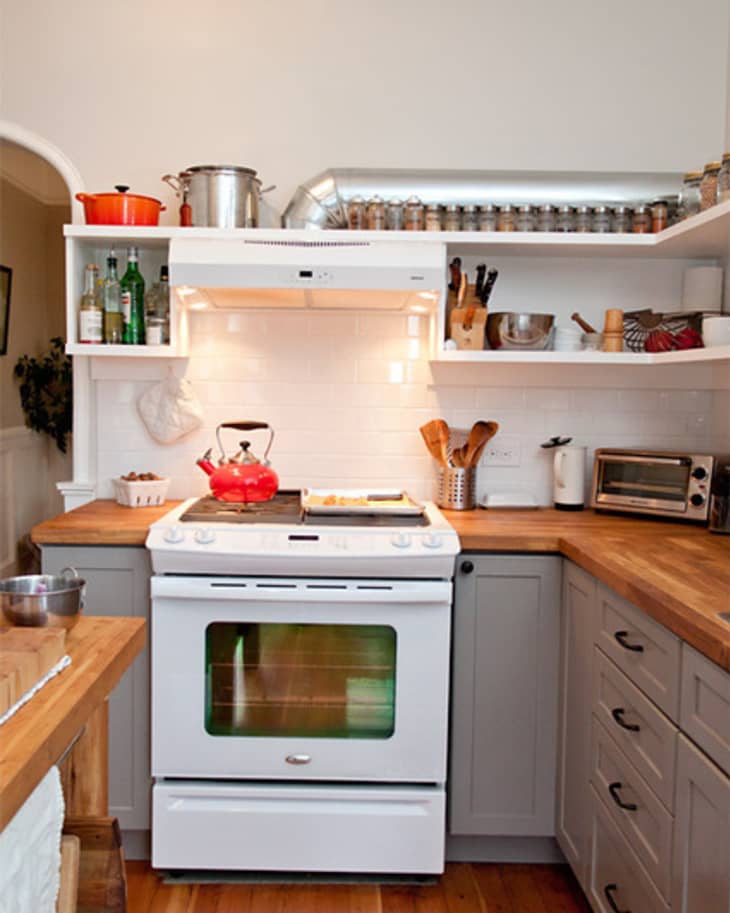All About: Butcher Block Countertops
Are you thinking about renovating your kitchen? Doing research on countertop materials? If so, then our Countertop Spotlight series will help you. Today we look at the beautiful warmth of butcher block countertops.
Material: Wood or Butcher Block
Styles: Edge grain butcher block tops have parallel wood rails that run the length of the piece. End grain butcher block tops are created by fusing together the end pieces of wood rails into a checkerboard pattern. End grain is considered the stronger and more durable style of the two.
Common Woods Used: Hardwoods like walnut, oak, maple, cherry, zebrawood, wenge, bamboo, or a mix of 3+ of these woods together.
Finish types: Drying oils (linseed, tung, diluted varnish); Nondrying oils (vegetable and mineral oils); paraffin or beeswax.
Environmental Impact: Mild to moderate, depending on the type of wood and whether or not it comes from salvaged or reclaimed sources or sustainably managed forests.
Pros: Warm look and feel; naturally anti-bacterial; strong and durable; biodegradable; affordable, particularly compared to granite or quartz countertops.
Cons: Requires bi-annual sanding and oiling to protect the wood; sealed counters should not be cut on.
Care: Maintenance depends on the type of finish you have. In general, wipe clean with damp cloth and mild soap. Avoid harsh detergents, chemicals, and puddles of standing water. Sand out light scratches, dents and dings with a high grit sandpaper. Recondition or oil when wood gets dull or shows signs of cracking or aging. (This protects the wood and helps guard against germs and mold.)
Installation: Make sure the butcher block counter has adequate ventilation as wood can expand and contract with temperature changes.
Cost: Pre-assembled or pre-fabricated sections start around $60.
Kitchn Reader Reviews:
I love my butcher block countertop! My husband made it for me (it’s actually economical if you buy the pieces of wood and install it yourself) and it takes me kitchen from ordinary to an extraordinary place to cook and bake, especially the large loaves of sourdough I bake regularly. I try not to use sharp knives on it, as it will damage the finish over time, but it can always be sanded and resealed. It will last forever! – rjgintrepid
I’m on year three with my IKEA butcher block counters and they still look great. And while I treated them several times with Tried & True Danish Oil when I first got them, I think I’ve only re-treated once since. (Oops.) I priced Ceasarstone, which my mom has an loves, for our small counter. I think it was about $1,800 and a 6 week wait. I got the butcher block for about $300. Just saying… – KateF
I’ve got butcher block. Love the look, hate the upkeep. It’s very persnickety around the sink, under the dishrack. I even had to go get plastic feet to put under the dish drainer, otherwise we’d get mold. It’s about time for another sand’n’seal. We also don’t use ours for cutting. – kdkaboom
When we moved into our house with a newly renovated kitchen, we had butcher block counters. I loved how they looked, but had all the problems people cited with mold and not being able to cut on them if you’re keeping them sealed. (Thankfully, I had a big center island with ample butcher block which I could use for cutting.) So, I ended up removing the butcher block counter tops and replacing them with a “manufactured” quartz (Viatera) surface. – Browse
Related Kitchn Posts:
• Beautiful and Useful: Butcher Block Counters
• How To Sand Your Butcher Block To Look Like New
• All About: Quartz Countertops
• All About: Granite Countertops
• Kitchen Design: A Look at Countertop Edge Profiles
Other Recommended Reading
• How To Install a Butcher Block Countertop | This Old House
